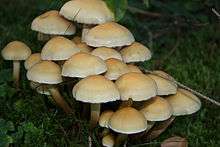Hypholoma capnoides
Hypholoma capnoides[1] is an edible mushroom in the family Strophariaceae. Like its poisonous or suspect relatives H. fasciculare ("sulphur tuft") and H. lateritium ("brick caps") grows on decaying wood, for example in tufts on old tree stumps.
| Hypholoma capnoides | |
|---|---|
 | |
| Scientific classification | |
| Kingdom: | Fungi |
| Division: | Basidiomycota |
| Class: | Agaricomycetes |
| Order: | Agaricales |
| Family: | Strophariaceae |
| Genus: | Hypholoma |
| Species: | H. capnoides |
| Binomial name | |
| Hypholoma capnoides | |
| Synonyms | |
| |
| Hypholoma capnoides | |
|---|---|
float | |
| gills on hymenium | |
| cap is convex | |
| hymenium is adnate | |
| stipe has a ring | |
| spore print is brown | |
| ecology is saprotrophic | |
| edibility: edible but not recommended | |
Edibility
Though edible,[2] anyone willing to risk eating this mushroom needs to be able to distinguish it from sulphur tuft, which is more common in many areas. H. capnoides has greyish gills due to the dark color of its spores, whereas sulphur tuft has greenish gills. It could also perhaps be confused with the deadly Galerina marginata or the good edible Kuehneromyces mutabilis.[3]
Description
- Cap: Up to 60 mm in diameter with yellow-to-orange-brownish or matt yellow colour.
- Gills: Initially pale orangish-yellow, pale grey when mature, later darker purple/brown.
- Spore powder: Dark burgundy/brown.
- Stipe: Yellowish, somewhat rust-brown below.
- Taste: Mild (other Hypholomas mostly have a bitter taste).[3]
gollark: Also recursion.
gollark: DO NOT submit your own as it would complicate things.
gollark: Wow, that's a great incentive actually.
gollark: Such as `entry = sorted`.
gollark: I have many ideas.
References
- Kummer P (1871) Führ. Pilzk. (Zwickau): 72.
- Phillips, Roger (2010). Mushrooms and Other Fungi of North America. Buffalo, NY: Firefly Books. p. 216. ISBN 978-1-55407-651-2.
- Gerhardt E (2006) BLV Handbuch Pilze. BLV, München. Seite 244. ISBN 3-8354-0053-3.
Most content to date (March 2020) taken from the German page.
This article is issued from Wikipedia. The text is licensed under Creative Commons - Attribution - Sharealike. Additional terms may apply for the media files.